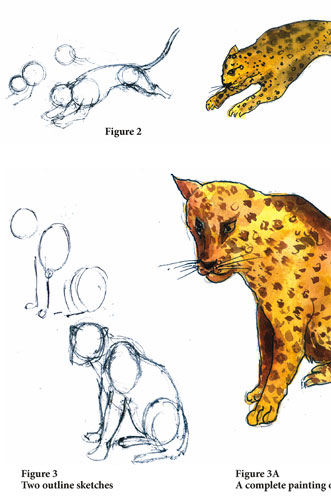Painting a leopard
Learn to draw by Tissa Hewavitharana
 The
leopard is a popular animal for artists, especially for wildlife artists
to paint. Leopards are found in the jungles and wildlife sanctuaries and
their staple food is meat. The
leopard is a popular animal for artists, especially for wildlife artists
to paint. Leopards are found in the jungles and wildlife sanctuaries and
their staple food is meat.
The leopard is somewhat a domestic cat and so is familiar in
appearance. The graceful way it moves gives the impression of a majestic
look. It is likely to lie fairly still for a long time, giving you time
to study and paint.
Figure 1: The sketch shows the outline. I have drawn three oval shape
circles with a 2B pencil to get the correct formation of the animal
before painting.
Figure 1A shows a complete structure of the animal. A wash of pale
yellow ochore is applied over the whole body before going into details.
Figure 2 shows an outline sketch, a profile of the leopard on the move,
drawn with a 2B pencil and 2A a coloured sketch.
Notice the basic outlines drawn in oval shape in figure 2 to give the
formation of the body before painting. In painting a thin layer of
yellow orchore is applied.

After the paint is dried you may introduce the spots with a pointed
brush.
In Figure 3A a complete coloured painting is shown. At first a pale
yellow wash is applied over the body and later shades of dark colour
applied to show the texture of the skin.
Finally, spots are shown on the leopard's body done with a fine
pointed brush or thin nib pen. Next the ears, toes, claws, nose and eyes
are defined with a fine brush. A mixture of burnt sienna with little
black is used to build up the small dark areas of fur on the muzzle and
around the eyes, nostrils, mouth and eyes. The drawing paper to be used
is 180 grams Kent paper or 150 gram Whatman paper. Brushes Sable hair or
Windsor and Newton No. 1,2,3, 6 or 8. To get your colour mixture perfect
you may do several paintings. |


